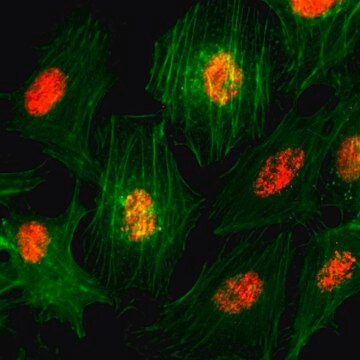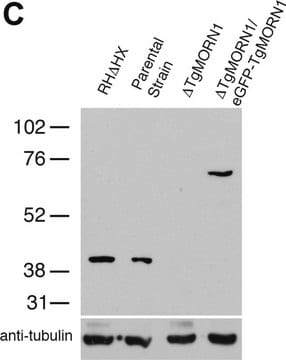Opis ogólny
Histon H4 (UniProt P62805; znany również jako H4 histone family member A, Histone 1 H4a) jest kodowany przez gen HIST1H4A (znany również jako H4/A, H4FA) (Gene ID 8359) u człowieka. Histon H4 jest jednym z głównych białek histonowych, które przyczyniają się do struktury chromatyny zarówno w komórkach prokariotycznych, jak i eukariotycznych. Histon H4 może podlegać kilku różnym typom modyfikacji epigenetycznych, które wpływają na procesy komórkowe, w tym metylacji i acetylacji na resztach lizyny i argininy, fosforylacji na resztach seryny i treoniny, a także konwersji Arg3 do reszty cytruliny w reakcji deiminazy peptydyloargininy katalizowanej przez PAD4, znanej również jako cytrulinacja). Cytrulinacja histonu H4 Arg3 (H4Cit3) osłabia interakcję histon-DNA w wyniku zmiany konformacyjnej i zmniejszonego ładunku dodatniego na N-końcowym końcu histonu H4. Wiadomo, że infekcja bakteryjna stymuluje H4Cit3 w neutrofilach, tworząc wysoce zdekondensowaną zewnątrzkomórkową strukturę chromatyny NET (neutrofilowa pułapka zewnątrzkomórkowa), która może wychwytywać i zabijać mikroorganizmy. Z drugiej strony, cytrulinowane białka są rozpoznawane jako białka nieswoje, a następnie aktywują układ odpornościowy. Wykazano, że funkcjonalny haplotyp genu PADI4 jest związany z patogenezą reumatoidalnego zapalenia stawów poprzez indukcję antygenowości białek. H4Cit3 jest indukowany w odpowiedzi na uszkodzenie DNA poprzez szlak p53-PADI4, co skutkuje zwiększoną immunoreaktywnością H4Cit3 zlokalizowaną wokół pofragmentowanych jąder w komórkach apoptotycznych. Ponadto poziom H4Cit3 jest ujemnie skorelowany z ekspresją białka p53 i wielkością guza w tkankach niedrobnokomórkowego raka płuc (NSCLC), co wskazuje na kluczową rolę H4Cit3 w kancerogenezie.
Specyficzność
Przewiduje się, że reaguje z szerokim zakresem gatunków na podstawie 100% homologii sekwencji.
To królicze przeciwciało poliklonalne wykrywało katalizowaną przez PAD4 cytrulinację Arg3 rekombinowanych histonów H4 i H2A, a także indukowaną jonoforami wapnia cytrulinację histonu H4 Arg3 (H4Cit3) w komórkach HL-60. Znokautowanie komórkowej PAD4 (deiminazy peptydyloargininowej 4) znacznie zmniejszyło H4Cit3 indukowaną jonoforem, podczas gdy blokowanie przeciwciał peptydem immunogennym uniemożliwiło wykrycie pasma docelowego (Tanikawa, C., et al. (2012). Nat. Commun. 3:676; Wang, Y., et al. (2004). Science. 306(5694):279-283).
Immunogen
Epitop: N-terminus
Sprzężony z KLH, syntetyczny peptyd odpowiadający aminokwasom 1-10 (SG[cit]GKGGKGL-C) ludzkiego histonu H4 (usunięty Met1), gdzie [cit] oznacza cytrulinowany Arg3. C-końcowa cysteina została dodana do celów koniugacji.
Zastosowanie
Anty-Histone H4 (Citrulline 3) Antibody, Cat. 07-596, jest wysoce specyficznym króliczym przeciwciałem poliklonalnym, które celuje w cytrulinację histonu H4 (H4Cit3) i zostało przetestowane w immunoprecypitacji chromatyny (ChIP), immunocytochemii, immunohistochemii i Western Blotting.
Kategoria badawcza
Epigenetyka i funkcje jądrowe
Podkategoria badawcza
Histony
Jakość
Evaluated by Western Blotting in HL-60 cell lysate.
Western Blotting Analysis: A 1:1,000 dilution of this antibody detected differentiation-induced histone H4 Arg3 citrullination (H4Cit3) in 10 µg of lysate from calcium ionophore-treated HL-60 cells.
Opis wartości docelowych
Zaobserwowano ~12 kDa. Obliczono 11,24/11,37 kDa (H4 z/bez usunięcia Met1). W niektórych lizatach można zaobserwować niescharakteryzowane pasma.
Postać fizyczna
Oczyszczone królicze przeciwciało poliklonalne w buforze zawierającym 0,1 M Tris-Glicyna (pH 7,4), 150 mM NaCl z 0,05% azydkiem sodu.
Oczyszczony metodą powinowactwa.
Przechowywanie i stabilność
Przechowywać przez 1 rok w temperaturze 2-8°C od daty otrzymania.
Inne uwagi
Stężenie: Należy zapoznać się z arkuszem danych dla konkretnej partii.
Informacje prawne
UPSTATE is a registered trademark of Merck KGaA, Darmstadt, Germany
Oświadczenie o zrzeczeniu się odpowiedzialności
O ile nie określono inaczej w naszym katalogu lub innej dokumentacji firmy dołączonej do produktu(-ów), nasze produkty są przeznaczone wyłącznie do użytku badawczego i nie mogą być wykorzystywane do żadnych innych celów, w tym między innymi do nieautoryzowanych zastosowań komercyjnych, zastosowań diagnostycznych in vitro, zastosowań terapeutycznych ex vivo lub in vivo lub jakiegokolwiek rodzaju konsumpcji lub zastosowania u ludzi lub zwierząt.
Ta strona może zawierać tekst przetłumaczony maszynowo.













